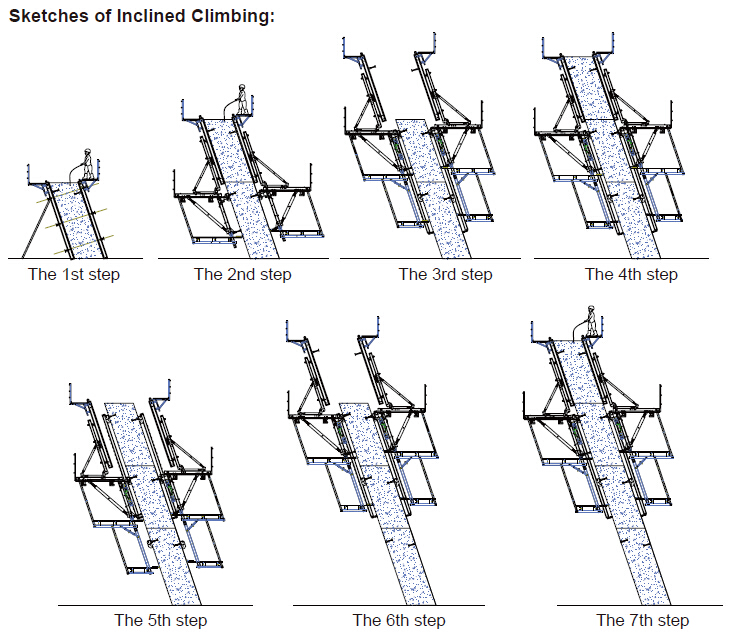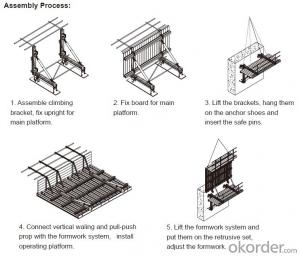Auto Climbing Bracket ACB-100 & ACB-50 for formwork and scaffolding systems
- Loading Port:
- Tianjin
- Payment Terms:
- TT OR LC
- Min Order Qty:
- 50 m²
- Supply Capability:
- 1000 m²/month
OKorder Service Pledge
OKorder Financial Service
You Might Also Like
Auto-climbing Bracket ACB100 & ACB50
The power of the auto-climbing formwork is the hydraulic system, which includes the oil cylinder
and two commutators. The commutators can control the climbing of climbing rail and the bracket.
The steel rail and the bracket can inter-climbing, so the whole system will climb up steadily.
Cranes are not needed during the construction. It’s easy to operate, highly efficient and safe. It’s
the best choice for the construction of high buildings and bridges.
There are mainly two types of standard auto-climbing brackets, ACB-50 and ACB-100, the figure
means the push power of cylinder with unit of KN.
Characteristics:
◆ Perfect load bearing anchor system
Anchor system is the most important supporting part. The system is made of five parts shown
below. Thereinto, tensile bolt, V-climbing cone and washer can be taken out for reusing after the
concrete pouring finished.There are two kinds of anchor systems,A & B. A is matched with single
anchor shoe and B is matched with double anchor shoe.
◆ Crane-independent
Crane-independent forming, striking and climbing speeds up the work procedures on the
construction site and also makes them independent of each other. This means the planned
sequences can be maintained along with guaranteeing high productivity levels. The crane can
therefore be used for other tasks.
Hydraulic system is mainly made of two commutators,
oil cylinder and power distribution system.The
commutators can control the climbing of climbing rail
and bracket.
◆ High bearing capacity and safe
The stable working platforms are able to carry large loads, e.g. the storage of reinforcing steel
for the next climbing section. Generously-sized working platforms, the well thought-out design for
handling very high wind loads and the patented control function of the climbing mechanism are
some of the special details contained within the comprehensive safety concept.
◆ Platforms adjusted to suit the angle of inclination
The horizontal working areas thus created provide safe and comfortable conditions for
reinforcement work, shuttering and striking, concreting and finishing.
◆ The ACB formwork system can climb not only vertically but also slantways, the largest angle is
18 degrees.
◆ The system can climb up wholly or separately. The climbing process is steady, synchronous
and safe.
◆ The bracket will not fall to the ground until the construction is finished, the field will be saved
and the impacting breakage will be reduced (especially the panel).
◆ The system will furnish omnidirectional platform, the construction organizations don’t need to
set up additional operation platform.
◆ The error of structure construction is small and easy to correct.
◆ The climbing speed is fast, the construction course will be quickened.
◆ The formwork can climb itself and cleaning work can be done in the same situs , the used times
of tower crane will be greatly reduced.

- Q: Can steel formwork be used for concrete structures in corrosive environments?
- No, steel formwork should not be used for concrete structures in corrosive environments as it may lead to corrosion of the steel and compromise the integrity of the structure.
- Q: Can steel formwork be used for curved or non-standard concrete shapes?
- Yes, steel formwork can be used for curved or non-standard concrete shapes. Steel formwork is flexible and can be easily customized to create various shapes and designs. It provides strength and stability to the concrete structure, making it suitable for complex and unique shapes. Additionally, steel formwork allows for efficient construction processes and can be reused multiple times, making it a cost-effective option for curved or non-standard concrete shapes.
- Q: How is steel formwork secured to the ground?
- Steel formwork is typically secured to the ground by using steel stakes or pins driven into the soil, anchors or bolts embedded in concrete foundations, or by using mechanical devices such as clamps or brackets that fasten the formwork to existing structures or other supporting elements.
- Q: How does steel formwork affect the overall flexibility of the construction process?
- Steel formwork can significantly enhance the overall flexibility of the construction process. Due to its robustness and durability, steel formwork allows for the creation of complex and intricate designs, making it suitable for various construction projects. It enables the construction team to easily modify and adapt the formwork to meet specific project requirements, resulting in a more flexible construction process. Additionally, steel formwork can be easily dismantled and reused, providing cost-saving benefits and reducing construction waste.
- Q: Is steel formwork suitable for projects with high wind loads?
- Indeed, steel formwork proves itself as a suitable option for projects grappling with formidable wind loads. Renowned for its robustness, longevity, and steadfastness, steel formwork emerges as an exemplary selection for construction ventures besieged by elevated wind loads. By adeptly thwarting wind forces, steel formwork remains unyielding to deformation or harm in the face of tempestuous winds. Moreover, steel formwork guarantees an exceptional degree of dimensional precision, fortifying the structure against the exertions of wind while preserving its stability. Thus, steel formwork stands as a dependable and fitting choice for projects that confront formidable wind loads.
- Q: Can steel formwork withstand extreme weather conditions?
- Yes, steel formwork is designed to withstand extreme weather conditions. Steel is known for its strength and durability, making it highly resistant to harsh weather elements such as heavy rain, strong winds, and high temperatures. Additionally, steel formwork is often treated with protective coatings to further enhance its resistance to corrosion and degradation caused by extreme weather conditions.
- Q: Can steel formwork be used for concrete beams with varying cross-sections?
- Yes, steel formwork can be used for concrete beams with varying cross-sections. Steel formwork is highly versatile and can be easily adjusted and customized to accommodate different shapes and sizes of concrete beams. It offers flexibility in terms of formwork design and allows for the creation of complex and irregular shapes. Additionally, steel formwork provides excellent strength and durability, making it suitable for supporting the weight and pressure exerted by concrete during the pouring and curing process. Overall, steel formwork is an ideal choice for constructing concrete beams with varying cross-sections, as it offers adaptability, strength, and reliability.
- Q: How much time does it take to install steel formwork?
- The time it takes to install steel formwork can vary depending on various factors such as the size and complexity of the project, the expertise of the workers, and the availability of equipment. However, on average, it typically takes several hours to a few days to complete the installation process.
- Q: Are there any specific safety guidelines for steel formwork installation?
- Yes, there are specific safety guidelines for steel formwork installation. Here are some key safety measures that should be followed: 1. Training and Competency: All personnel involved in the steel formwork installation should receive proper training and be competent in their roles. This includes knowledge of the equipment, understanding of the installation procedures, and awareness of potential hazards. 2. Personal Protective Equipment (PPE): Workers should wear appropriate PPE, such as hard hats, safety glasses, gloves, and steel-toed boots, to protect against potential head injuries, eye injuries, hand injuries, and foot injuries. 3. Inspection and Maintenance: The steel formwork and all associated equipment should be inspected regularly to identify any defects or hazards. Any damaged or faulty parts should be repaired or replaced immediately to ensure safety during installation. 4. Hazard Identification and Control: Prior to installation, a thorough assessment of the work area should be conducted to identify potential hazards, such as overhead power lines, uneven ground, or confined spaces. Adequate measures should be taken to control these hazards, such as erecting barriers, using warning signs, or implementing fall protection systems. 5. Manual Handling: Proper lifting techniques should be used to prevent back injuries or strains. The use of mechanical aids, such as cranes or hoists, should be considered for heavy or awkward loads. 6. Fall Protection: Fall hazards are common during steel formwork installation, especially when working at heights. Adequate fall protection systems, such as guardrails, safety nets, or personal fall arrest systems, should be used to prevent falls and protect workers. 7. Communication and Coordination: Clear communication and coordination among the installation team is essential for a safe installation process. This includes regular safety briefings, ensuring everyone understands their roles and responsibilities, and maintaining an open line of communication for reporting any safety concerns. It is crucial to note that these guidelines may vary depending on the specific project, local regulations, and industry standards. Therefore, it is recommended to consult with relevant authorities, such as the project engineer or site safety officer, to ensure compliance with all necessary safety requirements.
- Q: Can steel formwork be used in architectural concrete projects?
- Yes, steel formwork can be used in architectural concrete projects. Steel formwork offers several advantages such as durability, reusability, and the ability to create complex shapes and designs. It provides a smooth and consistent finish to the concrete surface, making it suitable for architectural applications where aesthetics are important. Additionally, steel formwork can withstand high pressure and load, allowing for the construction of large and structurally sound concrete elements.
Send your message to us
Auto Climbing Bracket ACB-100 & ACB-50 for formwork and scaffolding systems
- Loading Port:
- Tianjin
- Payment Terms:
- TT OR LC
- Min Order Qty:
- 50 m²
- Supply Capability:
- 1000 m²/month
OKorder Service Pledge
OKorder Financial Service
Similar products
Hot products
Hot Searches

















